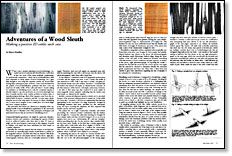
Synopsis: Bruce Hoadley presents a series of anecdotes that offer a sampling of the Wood technologist Bruce Hoadley shares anecdotes showing the surprising breadth of wood-identification applications in the real world. They also serve to illustrate a few of the principles, techniques, and anatomical features that are involved in identifying wood. His sampling covers disputes between lumberyards and customers, identifying wood in furniture at an art gallery, lawsuits, and favors for friends.
When I was a student majoring in wood technology, I accepted my wood anatomy and identification curriculum as just one more of the many academic requirements for professional competence. I knew my wood-identification skills were important in many phases of wood technology, but I gave little thought to ever using this expertise outside my chosen field. During these subsequent years, however, I have been fascinated by the parade of wood-identification problems that have come my way from all walks of life. Of the calls and letters I receive asking for assistance in identifying wood, only the occasional inquiry is directly related to my own profession as a wood technologist and then it usually involves some routine problem in lumber sales or manufacturing technology. Most of the requests come from the unrelated fields of science, commerce and law. In some cases, identifying the wood is the only matter of concern; in others, identifying one or more wood samples is but a small piece of a much larger and more complex problem.
The anecdotes that follow are offered as a sampling of the surprising breadth of wood-identification applications in the real world. They also serve to illustrate a few of the principles, techniques and anatomical features that are involved in identifying wood.
Commercial lumber questions
As might be expected, disputes between vendors and customers concerning the species of hardwood or softwood lumber arise from time to time. If I were to single out the most frequent controversy in this category, it would be whether soft maple has been substituted for hard maple in a lumber shipment.
Typically, the customer suspects that the lumber is not hard maple because an unusually large number of pith flecks is evident on the tangential surfaces of boards after they are dressed. Pith flecks are found regularly in soft maples; however, they are occasionally numerous in hard maple, Therefore, hard and soft maples are separated more reliably by examining the rays with a microscope, rather than with a hand lens.
From Fine Woodworking #88
For the full article, download the PDF below:
Fine Woodworking Recommended Products

DeWalt 735X Planer

Ridgid R4331 Planer

AnchorSeal Log and Lumber End-Grain Sealer





















Log in or create an account to post a comment.
Sign up Log in